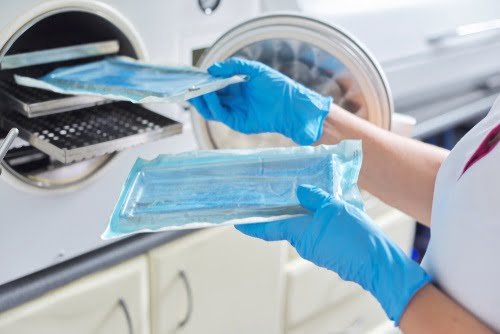Maintaining sterility is crucial in any dental practice. Ensuring that dental instruments are thoroughly cleaned and sterilized not only protects patients from infections but also upholds the reputation and safety standards of your practice. In this blog post, we will explore the importance of maintaining sterility, the methods used for cleaning dental instruments, and practical tips to ensure your practice remains compliant with health regulations.
The Importance of Sterility in Dental Practices
In the world of dentistry, sterility is paramount. Each tool that comes into contact with a patient’s mouth must be free from harmful microorganisms. Failure to maintain sterility can lead to severe infections and diseases, compromising patient safety and trust. Proper cleaning and sterilization of dental instruments are essential steps in preventing cross-contamination and ensuring patient well-being.
Understanding Sterilization vs. Disinfection
It’s essential to differentiate between sterilization and disinfection. Sterilization aims to eliminate all forms of microbial life, including bacteria, viruses, fungi, and spores. On the other hand, disinfection reduces the number of viable microorganisms to a safe level but may not eliminate all pathogens. In dental practices, both processes are vital, with sterilization being the final step after thorough cleaning and disinfection.
Pre-Cleaning Dental Instruments
Before sterilization, dental instruments must undergo a pre-cleaning phase. This step involves removing debris, blood, and other organic matter from the tools. Pre-cleaning can be done manually or using automated systems. Ensuring that instruments are free from visible contaminants is crucial for the effectiveness of subsequent sterilization procedures.
Manual Cleaning Techniques
Manual cleaning involves scrubbing instruments with brushes and cleaning agents. This method requires meticulous attention to detail to ensure all debris is removed. Dental professionals must wear protective gear, such as gloves and masks, to minimize the risk of exposure to harmful substances. While manual cleaning can be time-consuming, it is an essential step in maintaining sterility.
Automated Cleaning Systems
Automated cleaning systems, such as ultrasonic cleaners, offer a more efficient and consistent method of cleaning dental instruments. These systems use high-frequency sound waves to create microscopic bubbles that remove debris from instruments. An industrial ultrasonic cleaner is especially effective at reaching areas that are difficult to clean manually, ensuring thorough decontamination.
The Role of Ultrasonic Cleaners
Ultrasonic cleaners play a significant role in the cleaning process. By using cavitation, these devices create bubbles that implode, dislodging debris from instruments. This method is highly effective and reduces the risk of human error associated with manual cleaning. Dental practices often rely on ultrasonic cleaners to achieve optimal cleanliness before sterilization.
Rinsing and Drying Instruments
After pre-cleaning, instruments must be rinsed thoroughly to remove any remaining cleaning agents or debris. Using distilled or deionized water for rinsing helps prevent mineral deposits on the instruments. Once rinsed, instruments should be dried completely to prevent corrosion and ensure they are ready for sterilization.
Sterilization Methods
Various sterilization methods are available for dental instruments, each with its advantages and considerations. The most common methods include steam sterilization (autoclaving), chemical vapor sterilization, and dry heat sterilization. Selecting the appropriate method depends on the type of instruments and materials being sterilized.
Steam Sterilization (Autoclaving)
Steam sterilization, or autoclaving, is one of the most widely used methods in dental practices. This process involves exposing instruments to high-pressure steam at a specific temperature and duration. Autoclaving effectively kills microorganisms, including spores, ensuring instruments are safe for use. Regular maintenance and validation of autoclave machines are essential for consistent and reliable sterilization.
Chemical Vapor Sterilization
Chemical vapor sterilization uses a combination of chemicals, heat, and pressure to achieve sterilization. This method is particularly useful for instruments that may be sensitive to moisture. It offers a shorter cycle time compared to autoclaving and is effective against a wide range of microorganisms. Proper ventilation is necessary to ensure the safety of dental staff during the sterilization process.
Dry Heat Sterilization
Dry heat sterilization utilizes high temperatures to achieve sterilization without moisture. This method is suitable for instruments that may corrode or be damaged by steam or chemical exposure. While dry heat sterilization requires longer cycle times compared to other methods, it is highly effective in killing microorganisms.
Storing Sterilized Instruments
Proper storage of sterilized instruments is crucial to maintaining their sterility until they are used. Once sterilized, instruments should be stored in clean, dry conditions, away from potential contaminants. Sterilization pouches or wraps provide an additional layer of protection, ensuring instruments remain sterile until needed.
Regular Monitoring and Validation
To ensure the effectiveness of sterilization processes, regular monitoring and validation are necessary. Biological indicators, chemical indicators, and mechanical indicators can be used to verify that sterilization parameters are met consistently. Keeping detailed records of sterilization cycles and monitoring results helps maintain compliance with health regulations and ensures patient safety.
Conclusion
Maintaining sterility in dental practices is a critical aspect of patient care and safety. By following proper cleaning and sterilization procedures, dental professionals can prevent infections, protect their patients, and uphold the highest standards of hygiene. Investing in quality cleaning equipment, such as industrial ultrasonic cleaners, and adhering to best practices will contribute to a safer and more efficient dental practice.
Read more : Nobullswipe.com: Your Ultimate Health & Fitness Guide


